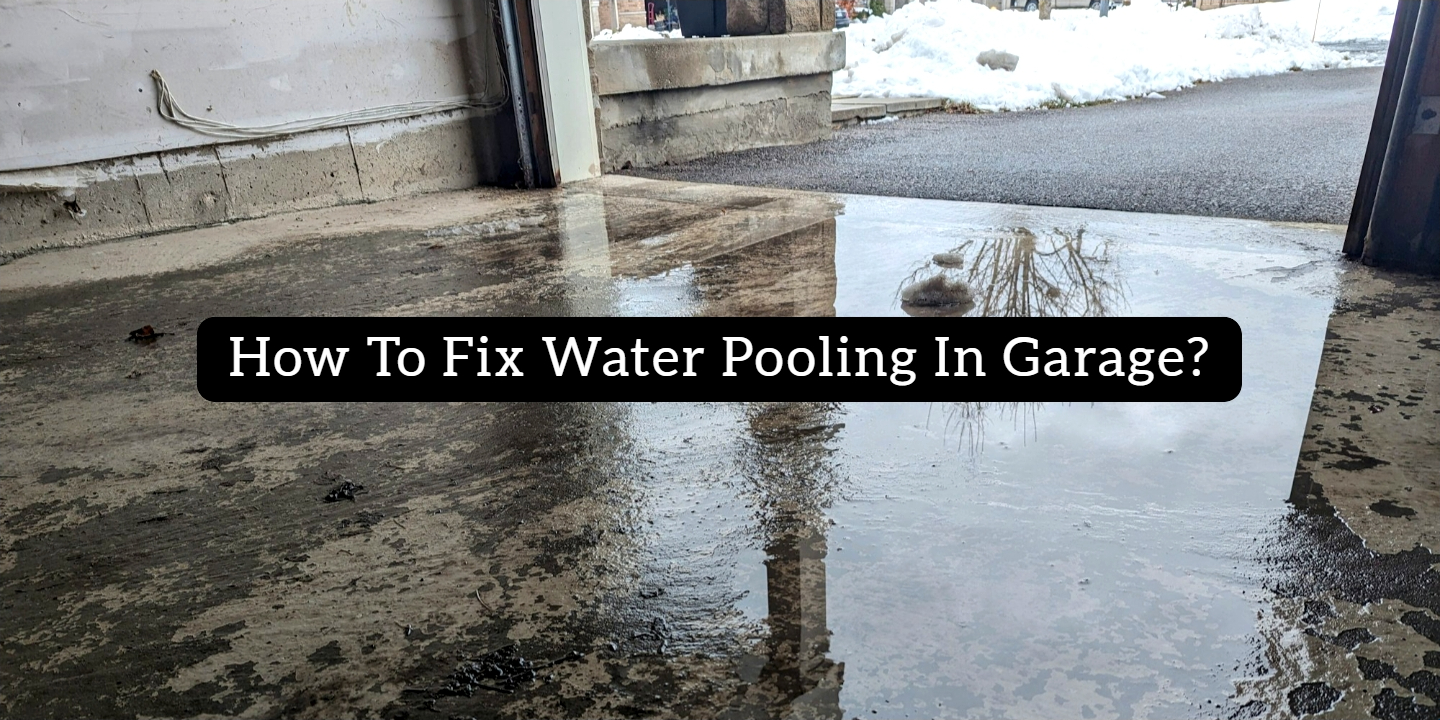Finding puddles in your garage? Don’t resign yourself to a soggy reality!
We’re here to tell you how to fix water pooling in a garage and stop it from happening. We’ll help you make your garage a waterproof and practical haven.
Prepare to learn the secrets behind those pesky puddles and discover how to fix all of them. So whether you’re dealing with stubborn low spots, mysterious leaks, or else, we’ll help you fix it. Let’s dive in!
Why Is Your Garage Pooling Water?
Water doesn’t appear in your garage magically. Identifying the source is crucial for tackling the problem effectively. Here are the main suspects:
Flooring Issues:
- Uneven Slab: Over time, your concrete slab might develop dips or slopes, making dampness to accumulate in low spots.
- Cracks and Gaps: Cracks in the slab or near the floor can allow moisture to seep in from outside.
- Poor Drainage: If your floor lacks a slope towards the exit, water has nowhere to go.
External Leakage:
- Foundation Leaks: Cracks or gaps in the foundation can allow rainwater to enter, especially near the perimeter walls.
- Downspout Misdirection: Improperly directed, they can channel rainwater towards your garage, causing pooling.
- Grading Issues: Sloping ground around your house can direct water towards the garage, leading to leaks and pooling.
- Sloped Driveway: A sloped driveway directing water towards your garage can contribute to pooling.
Internal Sources:
- Car Washing: Washing your car inside the garage can leave puddles that don’t properly drain.
- Appliance Leaks: Leaky washing machines, refrigerators, or water heaters can help.
- Roof Leaks: If your garage roof leaks, water can drip down and pool on the floor.
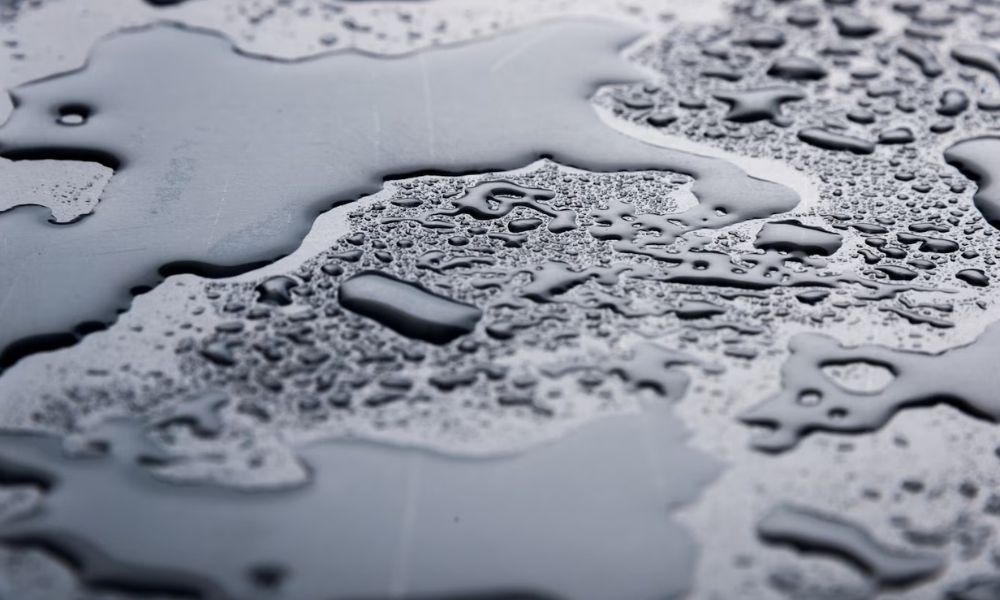
You may also like: 7 Best Steel Garage Trench Drains
Why Are Garages Vulnerable To Water Leaks?
The answer lies in a mix of design, exposure to the elements, and sometimes, neglect.
Design
Unlike your carefully insulated and sealed living space, garages often receive less construction TLC. This makes them inherently susceptible to water intrusion. Here’s why:
- Porous foundations: Garages typically have concrete slab foundations, which are surprisingly porous. So over time, cracks can develop, allowing water to seep through like a sponge.
- Missing barriers: Many garages lack waterproofing membranes under the slab, further increasing vulnerability to groundwater infiltration.
- Larger openings: Garages have large overhead doors, windows, and sometimes access points for utilities, creating more potential entry points for leaks.
- Minimal insulation: Compared to your house, garages are often uninsulated, making them colder in winter. And this temp difference can cause condensation on walls and ceilings, leading to drips and puddles.
Elements
Nature throws various curveballs at your garage, each posing a threat:
- Rainwater runoff: Sloping ground around your house can channel water towards the foundation, putting pressure on walls and contributing to leaks.
- Clogged gutters: Overflowing gutters dump excessive water near the foundation, increasing the risk of leaks and pooling.
- Downspout misdirection: If downspouts direct water toward the garage walls instead of away from them, trouble awaits.
- Wind-driven rain: Strong winds can push rain through even minor cracks or gaps, causing unexpected leaks.
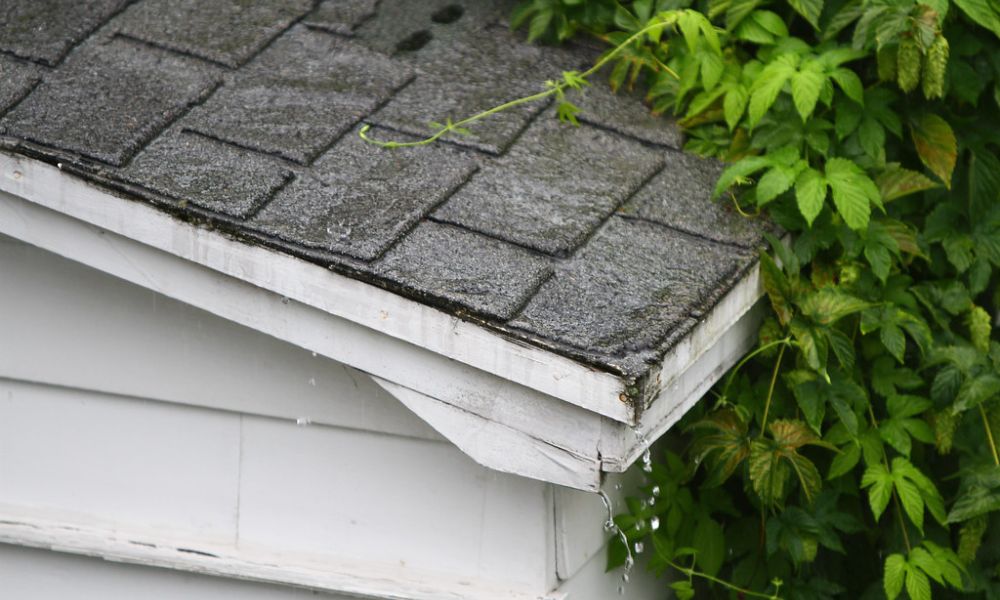
Self-Inflicted Woes
Sometimes, our own actions contribute to the problem:
- Improper car washing: Using the garage for car washing without proper drainage can leave puddles that contribute to moisture issues.
- Leaking appliances: Faulty washing machines, refrigerators, or water heaters can be silent culprits behind water woes.
- Ignoring maintenance: Neglecting regular inspections and repairs of roofs, gutters, and walls can lead to undetected leaks that worsen over time.
Check also: 8 Best Moisture Meters
How to Fix Water Pooling in Garage?
Now that you’ve identified the culprit, it’s time to select the appropriate solution:
Flooring faults:
Uneven slab:
- Minor dips: Use a concrete patching mix to fill them in, following proper preparation and manufacturer instructions.
- Significant slopes: For major unevenness, consider professional concrete leveling techniques like mudjacking or slabjacking.
Cracked foundation:
- Small cracks: Use a concrete crack sealant designed for garages. Fill the crack carefully, following the product instructions.
- Larger cracks: Consult a professional for larger cracks or those near the foundation. They can assess the severity and recommend appropriate repair methods, such as epoxy injections or underpinning.
Drainage dilemma:
- Reassess the slope: Check if the floor slopes slightly towards the garage door or a designated drain. Also, if not, consider grinding the concrete to create a gentle slope or installing a drainage channel.
- Install drains: If your garage lacks a drain, consider adding one, especially in low spots. So opt for a floor drain connected to a sump pump or the existing drainage system.
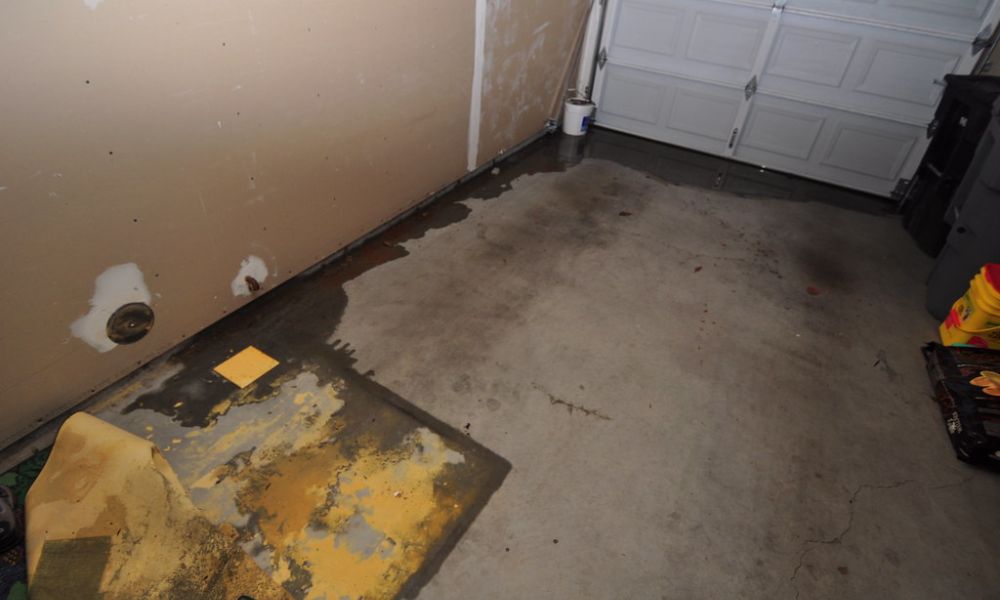
Wall issues:
- Cracked or damaged walls: Repair cracks in the walls using a suitable patching material like hydraulic cement or epoxy resin. So ensure proper preparation and follow the manufacturer’s instructions for a durable fix. For larger cracks or structural concerns, consult a professional contractor.
- Missing or faulty sealant: Apply appropriate sealant around windows, doors, and other openings in the walls. Also, pick a sealant designed for exterior use and resistant to water and weather changes.
- Improper flashing: Inspect and replace damaged or worn-out flashing around windows, doors, and other openings. Ensure proper installation of new flashing according to building codes and best practices. Also, consult a pro roofer for complex flashing repairs or installations.
Cracks and Gaps:
- Small Cracks: For hairline cracks, use a concrete crack sealant specifically designed for garages. Fill the crack carefully, following the product instructions.
- Larger Cracks: Consult a professional for larger cracks or those near the foundation. They can assess the severity and recommend appropriate repair methods, such as epoxy injections or underpinning.
Poor Drainage:
- Reassess the Slope: Check if the floor slopes slightly towards the door or a designated drain. If not, consider grinding the concrete to create a gentle slope or installing a drainage channel.
- Install Drains: If your space lacks a drain, think of adding one, especially in low spots. Also, opt for a floor drain connected to a sump pump or the existing drainage system.
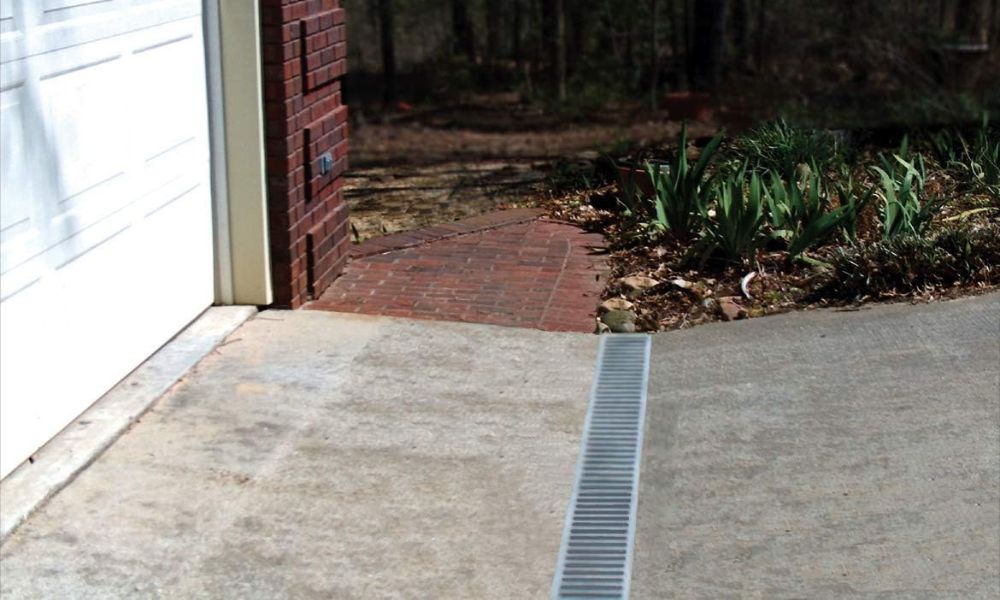
External Leakage:
- Foundation Leaks: Seal any visible cracks or gaps in the foundation with appropriate caulk or sealant. For larger or deeper cracks, consult a professional for proper repair.
- Downspout Misdirection: Redirect downspouts away from the floor and the garage. Extend them to discharge water at least 6 feet away from the structure.
- Grading Issues: If your yard slopes towards the garage, consider regrading the soil to divert moisture away from the foundation. So consult a landscaping pro for this task.
- Address Driveway Slope: If your driveway slopes towards the garage, consider installing an open-top drain or a “speed bump” to divert water away.
Internal Sources:
- Car Washing: Avoid washing your car inside the garage. And if you must, ensure proper drainage and promptly clean up any spills.
- Appliance Leaks: Address any leaks in appliances immediately. Repair or replace malfunctioning units to prevent further water damage.
- Roof Leaks: Locate and repair any roof leaks promptly to prevent water from entering the garage. Then, consult a pro for complex roof repairs.
Have a look at: Universal Garage Door Bottom Seal Reviews (Top 7 Goods)
How To Get Rid Of Standing Water In Your Garage?
Although we’ve covered ways to fix your issues, you’ll still need to get rid of all that water, right? It can be a stressful experience, but with quick action and the right approach, you can minimize damage and get things back to normal. Here’s how to do it:
Assess the Situation
- Safety first: Before diving in, ensure the power is off to avoid electrical hazards. So wear protective clothing like gloves and boots to prevent cuts or contact with contaminated water.
- Water level and damage: Gauge the extent of the flooding and assess damage to your belongings. Also, always prioritize drying out items most susceptible to such damage.
Remove Standing Water
- Get rid of the bulk: Use buckets, squeegees, or a wet/dry vacuum to remove as much standing water as possible. Start from the highest points and work your way down, leading water towards the door or a drain if available.
- Salvage what you can: Move salvageable items to dry areas outside the garage. Elevate them off the ground to prevent further water damage.
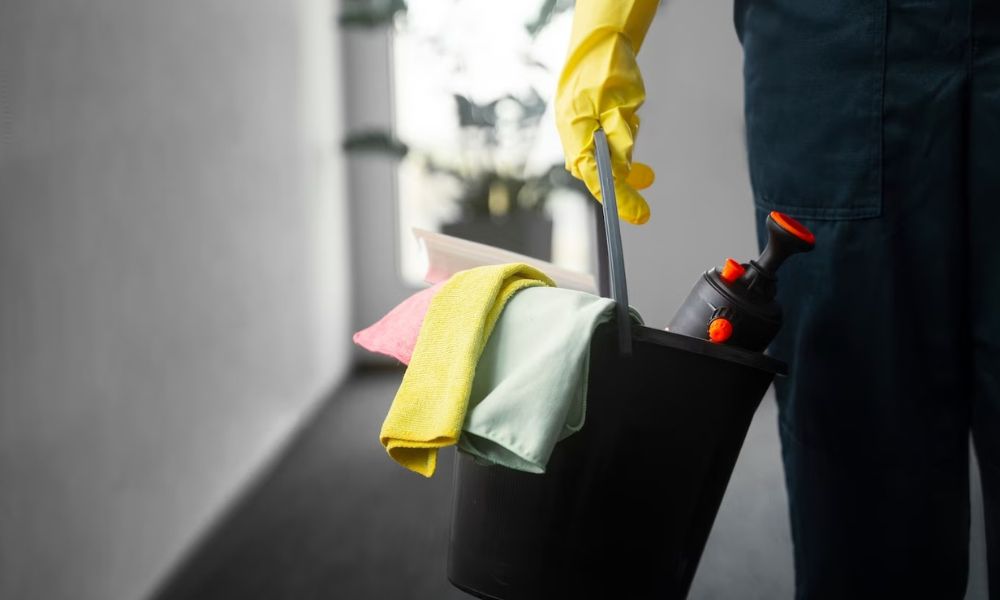
Promote Drying and Prevent Mold
- Open doors and windows: Maximize ventilation to allow fresh air to circulate and promote natural drying. Use box fans or oscillating fans to further accelerate the process.
- Dehumidify the air: Rent or purchase a commercial-grade dehumidifier to draw moisture from the air. Run it continuously for at least 3-5 days, depending on the severity of the flood. Then empty the water tank regularly to maintain its efficiency.
- Target damp areas: For stubborn damp areas, use absorbent materials like towels, rags, or moisture-absorbing pads to soak up excess water. Replace them frequently as they get saturated.
Deep Cleaning and Sanitation
- Clean and disinfect: Once the area is dry, thoroughly clean and disinfect surfaces that come in contact with floodwater. Use a bleach solution or a commercially available disinfectant following the manufacturer’s instructions. Also, pay close attention to areas prone to mold growth, like corners, crevices, and under cabinets.
- Dry walls and insulation: Inspect drywall for water damage. So if it feels soft or shows water stains, remove affected sections and allow the underlying insulation to dry completely. Replace damaged drywall with new material and ensure proper insulation is reinstalled.
- Clean and dry belongings: Clean and dry salvaged belongings. For electronics, ensure they are completely dry before attempting to use them. Wash fabrics and clothing according to care instructions. Then discard items beyond repair or with potential health hazards.
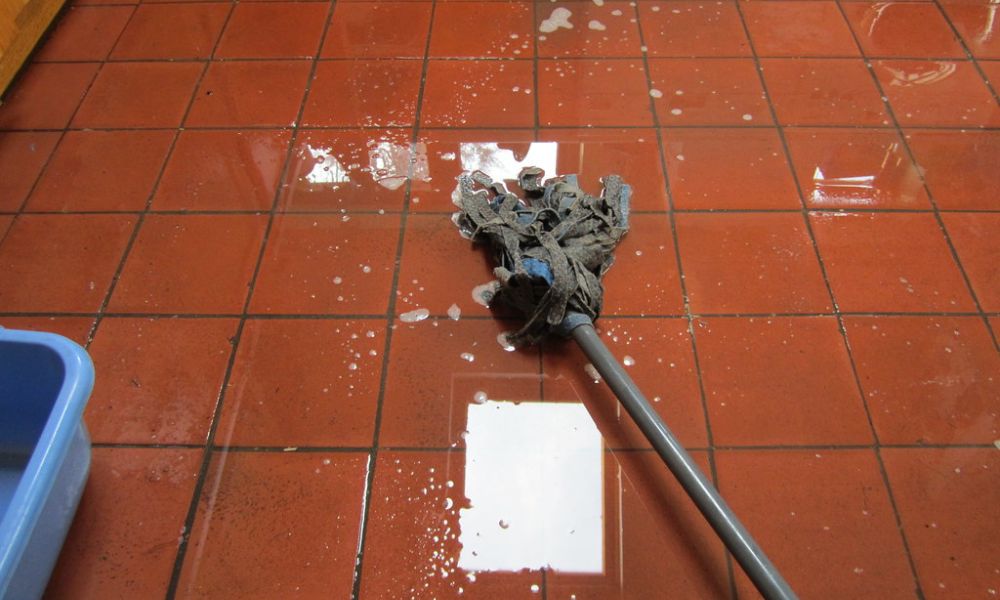
Additional Tips:
- Document the flood damage with photos and videos for insurance purposes.
- Keep receipts for any equipment rentals or supplies purchased.
- Consider contacting your insurance company to understand your coverage and potential claim options.
How To Prevent Water Pooling In Your Garage?
Prevention is key! Here’s how to keep those puddles at bay:
Add A Drain
Sometimes you need an extra line of defense. In cases where water stocks, adding a floor drain can be a game-changer. So here’s what you need to know:
When to consider a drain:
- Low spots: If your floor has dips or low points where water naturally gathers, a drain installed in the lowest point can prevent pooling.
- Frequent car washing: If you regularly wash your car inside the garage, even with proper precautions, a drain can handle any stray splashes or spills.
- Potential future leaks: While addressing leaky appliances or roof issues is crucial, adding a drain provides additional peace of mind in case of unforeseen leaks.
Choosing the right drain:
- Floor drains: These connect directly to your existing drainage system or a sump pump, efficiently removing water from the lowest point.
- French drains: These gravel-filled trenches installed along the perimeter accumulate and redirect water away from your garage.

Installation considerations:
- Professional help: Adding a drain usually involves cutting into the concrete slab, so seeking professional assistance is recommended, especially for complex installations.
- Permits: Depending on your local regulations, you may need a permit for drain installation. Check with your local authorities before proceeding.
- Location and slope: Ensure the drain is positioned strategically in the lowest point and the garage floor slopes slightly towards it for optimal drainage.
Remember! Adding a drain is just one piece of the puzzle. These can also help:
- Regular inspections: Inspect your roof, gutters, downspouts, and foundation regularly for potential leaks. Maintain proper drainage by keeping gutters clean and ensuring downspouts function properly.
- Sealant: Seal cracks and gaps around windows, doors, and the floor to prevent water infiltration. Use caulk or sealant appropriate for the material.
- Grading: Ensure proper grading around your house to divert water away from the floor.
- Appliances: Address any minor appliance leaks promptly to prevent bigger issues down the line.
- Car wash: Stick to designated car wash areas to avoid creating a watery mess in your garage.

